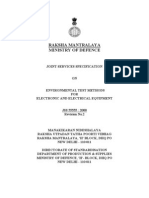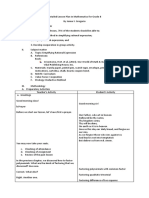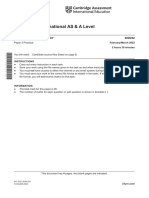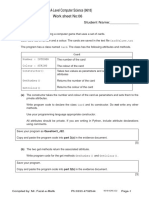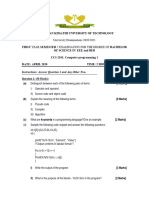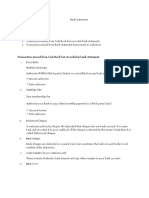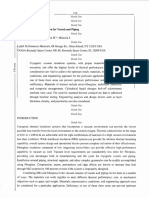PreDefined VB - Net Functions
PreDefined VB - Net Functions
Uploaded by
Mohd NafishCopyright:
Available Formats
PreDefined VB - Net Functions
PreDefined VB - Net Functions
Uploaded by
Mohd NafishOriginal Description:
Original Title
Copyright
Available Formats
Share this document
Did you find this document useful?
Is this content inappropriate?
Copyright:
Available Formats
PreDefined VB - Net Functions
PreDefined VB - Net Functions
Uploaded by
Mohd NafishCopyright:
Available Formats
METHODS
A Method is a procedure built into the class. They are a series of statements that are executed when
called. Methods allow us to handle code in a simple and organized fashion. There are Broadly two types
of methods in VB .NET: those that return a value (Functions) and those that do not return a value (Sub
Procedures). Both of them are discussed below.
Sub Procedures
Sub procedures are methods which do not return a value. Each time when the Sub procedure is called
the statements within it are executed until the matching End Sub is encountered.
Functions
Function is a method which returns a value. Functions are used to evaluate data, make calculations or to
transform data. Declaring a Function is similar to declaring a Sub procedure. Functions are declared with
the Function keyword.
Parameters
A parameter is an argument that is passed to the method by the method that calls it. Parameters are
enclosed in parentheses after the method name in the method declaration. You must specify types for
these parameters. The general form of a method with parameters looks like this:
Public Function Add(ByVal x1 as Integer, ByVal y1 as Integer)
-----------Implementation
-----------End Function
IN BUILT FUNCTIONS IN VB.NET
VB String-Handling Functions
VB has numerous built-in functions for processing strings. Most VB string-handling functions return a
string, although some return a number (such as the Len function, which returns the length of a string and
functions like Instr and InstrRev, which return a character position within the string). The functions that
return strings can be coded with or without the dollar sign ($) at the end, although it is more efficient to
use the version with the dollar sign.
Function:
Len
Description:
Returns a Long containing the length of the specified string
Syntax:
Len(string)
Where string is the string whose length (number of characters) is to be returned.
Example:
lngLen = Len("Visual Basic")
Function:
Mid$ (or Mid)
Description:
Returns a substring containing a specified number of characters from a string.
Syntax:
Mid$(string, start[, length])
' lngLen = 12
The Mid$ function syntax has these parts:
Part
string
Description
Required. String expression from which characters are returned.
start
Required; Long. Character position in string at which the part to be taken
begins. If start is greater than the number of characters in string, Mid returns a
zero-length string ("").
length Optional; Long. Number of characters to return. If omitted or if there are fewer
than length characters in the text (including the character at start), all
characters from the start position to the end of the string are returned.
Example:
strSubstr = Mid$("Visual Basic", 3, 4)
"sual"
' strSubstr =
Note: Mid$ can also be used on the left side of an assignment statement, where you
can replace a substring within a string.
Example:
strTest = "Visual Basic"
Mid$(strTest, 3, 4) = "xxxx"
'strTest now contains "Vixxxx Basic"
In VB6, the Replace$ function was introduced, which can also be used to
replace characters within a string.
Function:
Left$ (or Left)
Description:
Returns a substring containing a specified number of characters from the beginning
(left side) of a string.
Syntax:
Left$(string, length)
The Left$ function syntax has these parts:
Part
Description
string Required. String expression from which the leftmost characters are returned.
length Required; Long. Numeric expression indicating how many characters to
return. If 0, a zero-length string ("") is returned. If greater than or equal to the
number of characters in string, the entire string is returned.
Example:
strSubstr = Left$("Visual Basic", 3)
' strSubstr = "Vis"
' Note that the same thing could be accomplished with Mid$:
strSubstr = Mid$("Visual Basic", 1, 3)
Function:
Right$ (or Right)
Description:
Returns a substring containing a specified number of characters from the end (right
side) of a string.
Syntax:
Right$(string, length)
The Right$ function syntax has these parts:
Part
Description
string Required. String expression from which the rightmost characters are returned.
length Required; Long. Numeric expression indicating how many characters to
return. If 0, a zero-length string ("") is returned. If greater than or equal to the
number of characters in string, the entire string is returned.
Example:
strSubstr = Right$("Visual Basic", 3)
' strSubstr = "sic"
' Note that the same thing could be accomplished with Mid$:
strSubstr = Mid$("Visual Basic", 10, 3)
Function:
UCase$ (or UCase)
Description:
Converts all lowercase letters in a string to uppercase. Any existing uppercase letters
and non-alpha characters remain unchanged.
Syntax:
UCase$(string)
Example:
strNew = UCase$("Visual Basic")
BASIC"
' strNew = "VISUAL
Function:
LCase$ (or LCase)
Description:
Converts all uppercase letters in a string to lowercase. Any existing lowercase letters
and non-alpha characters remain unchanged.
Syntax:
LCase$(string)
Example:
strNew = LCase$("Visual Basic")
basic"
Function:
Instr
Description:
Returns a Long specifying the position of one string within another. The search starts
either at the first character position or at the position specified by the start argument,
and proceeds forward toward the end of the string (stopping when either string2 is
found or when the end of the string1 is reached).
Syntax:
InStr([start,] string1, string2 [, compare])
' strNew = "visual
The InStr function syntax has these parts:
Part
Examples:
Description
start
Optional. Numeric expression that sets the starting position for each
search. If omitted, search begins at the first character position. The start
argument is required if compare is specified.
string1
Required. String expression being searched.
string2
Required. String expression sought.
compare
Optional; numeric. A value of 0 (the default) specifies a binary (casesensitive) search. A value of 1 specifies a textual (case-insensitive)
search.
lngPos = Instr("Visual Basic", "a")
' lngPos = 5
lngPos = Instr(6, "Visual Basic", "a")
' lngPos = 9 (starting at position 6)
lngPos = Instr("Visual Basic", "A")
' lngPos = 0 (case-sensitive search)
lngPos = Instr(1, "Visual Basic", "A", 1)
' lngPos = 5 (case-insensitive search)
Function:
InstrRev
Description:
Returns a Long specifying the position of one string within another. The search starts
either at the last character position or at the position specified by the start argument,
and proceeds backward toward the beginning of the string (stopping when
either string2 is found or when the beginning of the string1 is reached).
Introduced in VB 6.
Syntax:
InStrRev(string1, string2[, start, [, compare]])
The InStr function syntax has these parts:
Part
Description
string1
Required. String expression being searched.
string2
Required. String expression sought.
start
Optional. Numeric expression that sets the starting position for each
search. If omitted, search begins at the last character position.
compare Optional; numeric. A value of 0 (the default) specifies a binary (casesensitive) search. A value of 1 specifies a textual (case-insensitive)
search.
Examples:
lngPos = InstrRev("Visual Basic", "a")
' lngPos = 9
lngPos = InstrRev("Visual Basic", "a", 6)
' lngPos = 5 (starting at position 6)
lngPos = InstrRev("Visual Basic", "A")
' lngPos = 0 (case-sensitive search)
lngPos = InstrRev("Visual Basic", "A", , 1)
' lngPos = 9 (case-insensitive search)
' Note that this last example leaves a placeholder for the
start argument
Notes on Instr and InstrRev:
Something to watch out for is that while Instr and InstrRev both accomplish the same thing (except
that InstrRev processes a string from last character to first, while Instr processes a string from first
character to last), the arguments to these functions are specified in a different order. The Instr
arguments are (start, string1, string2, compare) whereas the InstrRev arguments are (string1, string2,
start, compare).
The Instr function has been around since the earlier days of BASIC, whereas InstrRev was not
introduced until VB 6.
Built-in "vb" constants can be used for the compare argument:
vbBinaryCompare for 0 (case-sensitive search)
vbTextCompare for 1 (case-insensitive search)
Function:
String$ (or String)
Description:
Returns a string containing a repeating character string of the length specified.
Syntax:
String$(number, character)
The String$ function syntax has these parts:
Part
Description
number
Required; Long. Length of the returned string.
character Required; Variant. This argument can either be a number from 0 to 255
(representing the ASCII character code* of the character to be
repeated) or a string expression whose first character is used to build
the return string.
strTest = String$(5, "a")
' strTest = "aaaaa"
Examples:
strTest = String$(5, 97)
' strTest = "aaaaa" (97 is the ASCII code for "a")
* A list of the ASCII character codes is presented at the end of this topic.
Function:
Space$ (or Space)
Description:
Returns a string containing the specified number of blank spaces.
Syntax:
Space$(number)
Where number is the number of blank spaces desired.
Examples:
strTest = Space$(5)
' strTest = "
"
Function:
Replace$ (or Replace)
Description
:
Returns a string in which a specified substring has been replaced with another substring a
specified number of times.
Introduced in VB 6.
Syntax:
Replace$(expression, find, replacewith[, start[, count[, compare]]]
)
The Replace$ function syntax has these parts:
Part
expression
find
Description
Required. String expression containing substring to replace.
Required. Substring being searched for.
replacewith
Examples:
Required. Replacement substring.
start
Optional. Position within expression where substring search is to begin. If
omitted, 1 is assumed.
count
Optional. Number of substring substitutions to perform. If omitted, the
default value is 1, which means make all possible substitutions.
compare
Optional. Numeric value indicating the kind of comparison to use when
evaluating substrings. (0 = case sensitive, 1 = case-insensitive)
Built-in "vb" constants can be used for the compare argument:
vbBinaryCompare for 0 (case-sensitive search)
vbTextCompare for 1 (case-insensitive search)
strNewDate = Replace$("08/31/2001", "/", "-")
' strNewDate = "08-31-2001"
Function:
StrReverse$ (or StrReverse)
Description:
Returns a string in which the character order of a specified string is reversed.
Introduced in VB 6.
Syntax:
StrReverse$(string)
Examples:
strTest = StrReverse$("Visual Basic")
"cisaB lausiV"
Function:
LTrim$ (or LTrim)
Description:
Removes leading blank spaces from a string.
Syntax:
LTrim$(string)
Examples:
strTest = LTrim$(" Visual Basic
' strTest = "Visual Basic "
Function:
RTrim$ (or RTrim)
Description:
Removes trailing blank spaces from a string.
Syntax:
RTrim$(string)
Examples:
strTest = RTrim$("
Basic"
Function:
Trim$ (or Trim)
Visual Basic
' strTest =
")
")
' strTest = "
Visual
Description:
Removes both leading and trailing blank spaces from a string.
Syntax:
Trim$(string)
Examples:
strTest = Trim$("
Basic"
Visual Basic
")
' strTest = "Visual
' Note: Trim$(x) accomplishes the same thing as
LTrim$(RTrim$(x))
Function:
Asc
Description:
Returns an Integer representing the ASCII character code corresponding to the first
letter in a string.
Syntax:
Asc(string)
Examples:
intCode = Asc("*")
intCode = Asc("ABC")
Function:
Chr$ (or Chr)
Description:
Returns a string containing the character associated with the specified character code.
Syntax:
Chr$(charcode)
Where charcode is a number from 0 to 255 that identifies the character.
Examples:
strChar = Chr$(65)
' intCode = 42
' intCode = 65
' strChar = "A"
DATE AND TIME FUNCTIONS IN VB
Visual Basic supplies a complete set of date and time functions to extract dates and times from the
system clock and to manipulate these values for various computational and display purposes.
Date and Time Properties
When working with dates and times it is often necessary to know the current date and/or time. These
values can be extracted from the server's system clock through the properties shown in the table below.
These properties are used in several of the date and time functions described below.
Property
DateString
Now
TimeOfDay
to 1/1/0001).
Timer
midnight.
TimeString
Today
Value
Returns a String value representing the current date.
DateString = 02-17-2009
Returns a Date value containing the current date and time.
Now = 2/17/2009 10:00:33 AM
Returns a Date value containing the current time of day (the date is set
TimeOfDay = 1/1/0001 10:00:33 AM
Returns a Double value representing the number of seconds elapsed since
Timer = 36033.771923
Returns a String value representing the current time of day.
TimeString = 10:00:33
Returns or sets a Date value containing the current date.
Today = 2/17/2009 12:00:00 AM
Date Functions
Date functions are summarized in the following table with functions described more fully below.
Function
Use
DateAdd() Returns a Date value containing a date and time value to which a specified time interval has
been added.
DateDiff() Returns a Long value specifying the number of time intervals between two Date values.
DatePart() Returns an Integer value containing the specified component of a given Date value.
DateSerial() Returns a Date value representing a specified year, month, and day, with the time
information set to midnight (00:00:00).
DateValue()
Returns a Date value containing the date information represented by a string, with the
time information set to midnight
(00:00:00).
Day()
Returns an Integer value from 1 through 31 representing the day of the month.
IsDate()
Returns a Boolean value indicating whether an expression can be converted to a date.
Month()
Returns an Integer value from 1 through 12 representing the month of the year.
MonthName() Returns a String value containing the name of the specified month.
WeekDay() Returns an Integer value containing a number representing the day of the week .
Time Functions
Time functions are summarized in the following table with functions described more fully below. Several of
the date functions can be applied to time measurements.
STRING FUNCTIONS :-
What You Need to
Do Method or Property to Use
Get the Char at a specific index in the String
Char (p)
Get the length of the String
Length (p)
Compare two Strings
Compare (s),
CompareOrdinal (s)
Compare a target String to a source String
CompareTo
Join source String to target String
Concat (s)
Copy source String object to target String
Copy (s)
Clone the source String
Clone
Copy characters into an array
CopyTo
Test the beginning and ends of Strings
EndsWith, StartsWith
Format numeric Strings
Format (s)
Get the index location of characters in a String
IndexOf, LastIndexOf, LastIndexOfAny
Insert subStrings into a String
Insert
Obtain a reference to a String
Intern (s), IsInterned (s)
Manipulate subStrings
Join, Split (s)
Pad Strings with additional characters
PadLeft, PadRight
Remove characters from a String
Remove
Replace characters in a String
Replace
Isolate a subString from a String
SubString
Trim characters from the beginning and ends of Strings
Trim, TrimEnd, TrimStart
Copy the characters in the String to a Unicode character array ToCharArray
Covert all characters in the String to lowercase
ToLower
Return the value of the String object
ToString
Convert all the characters in the String to uppercase
ToUpper
You might also like
- JSSStandards - JSS 55555 - 2000Document358 pagesJSSStandards - JSS 55555 - 2000Rusha Rao89% (19)
- 7.1 The Program Development Life CycleDocument3 pages7.1 The Program Development Life CycleAnisha Bushra AkondNo ratings yet
- Lesson Plan For Grade 8 (Simplifying Rational Expression)Document6 pagesLesson Plan For Grade 8 (Simplifying Rational Expression)Jomar Gregorio90% (10)
- Structure Charts-WSDocument6 pagesStructure Charts-WSchexNo ratings yet
- Cambridge International AS & A Level: Information Technology 9626/02Document4 pagesCambridge International AS & A Level: Information Technology 9626/02jesuNo ratings yet
- Unit 2 ICS4U TestDocument8 pagesUnit 2 ICS4U TestAce Pierce100% (1)
- Cambridge IGCSE (9-1) : Computer Science 0984/22Document2 pagesCambridge IGCSE (9-1) : Computer Science 0984/22mohammed mahdyNo ratings yet
- 02 - Fundamentals of Ethernet LANsDocument36 pages02 - Fundamentals of Ethernet LANsAdetayo OnanugaNo ratings yet
- Installation Directions: Rosariosis Student Information SystemDocument3 pagesInstallation Directions: Rosariosis Student Information SystemDem GagatamNo ratings yet
- Legal Technique and Logic Course OutlineDocument4 pagesLegal Technique and Logic Course OutlineMaeJoyLoyolaBorlagdatan100% (1)
- Algorithm and Problem SolvingDocument9 pagesAlgorithm and Problem SolvingOvidiu SmocotNo ratings yet
- Chapter 9 Algorithm Design and Problem SolvingDocument29 pagesChapter 9 Algorithm Design and Problem Solvingmohamed galalNo ratings yet
- Gcse Information and Communication TechnologyDocument19 pagesGcse Information and Communication TechnologyAsif Zubayer PalakNo ratings yet
- Unit 1: Understanding Ict: A.M. FRIDAY, 13 January 2012 1 HoursDocument20 pagesUnit 1: Understanding Ict: A.M. FRIDAY, 13 January 2012 1 HoursAsif Zubayer PalakNo ratings yet
- Practical OOPDocument15 pagesPractical OOPfaheemrao33No ratings yet
- Chapter 27-OOP Questions: Mr. Mahmoud Moussa A2 CS 9618Document10 pagesChapter 27-OOP Questions: Mr. Mahmoud Moussa A2 CS 9618Eyad UsamaNo ratings yet
- FOC Practical Question SetDocument4 pagesFOC Practical Question SetShankarNo ratings yet
- CS 9618 NotesDocument17 pagesCS 9618 NotesHaneyya UmerNo ratings yet
- Top and Bottom in DsucDocument7 pagesTop and Bottom in Dsucvineet883No ratings yet
- 1.3.2 Computer Architecture Workbook by Inqilab PatelDocument35 pages1.3.2 Computer Architecture Workbook by Inqilab PatelAditya GhoseNo ratings yet
- CCS 2101 Computer Programming 1 Question paperEEE& BEDDocument5 pagesCCS 2101 Computer Programming 1 Question paperEEE& BEDomodiaesther12No ratings yet
- Computer Science 2022-Practical FileDocument32 pagesComputer Science 2022-Practical FileThupten ChoedupNo ratings yet
- Cala Guide 3Document5 pagesCala Guide 3Tiffany huniNo ratings yet
- Visual Basic 2019 Made Easy: by DR - LiewDocument33 pagesVisual Basic 2019 Made Easy: by DR - LiewAbhijit Jadhav100% (1)
- 9618 Chapter 23Document18 pages9618 Chapter 23Vasant Kumar SeechurnNo ratings yet
- SQL OverviewDocument3 pagesSQL OverviewkspNo ratings yet
- Computer Science 0478 - Paper - 2Document10 pagesComputer Science 0478 - Paper - 2TrynosNo ratings yet
- Computer Science Unit 2 Past PaperDocument16 pagesComputer Science Unit 2 Past PapermalaikaNo ratings yet
- 0417 m17 Ms 21Document29 pages0417 m17 Ms 21Mohammed MaGdy100% (1)
- Olevel Computer Science Notes 2210 PDFDocument18 pagesOlevel Computer Science Notes 2210 PDFEmaanNo ratings yet
- Building Java Programs: SortingDocument25 pagesBuilding Java Programs: SortingFrancisco ReinaNo ratings yet
- Revision Notes - 23 Data Transmission TechnologiesDocument15 pagesRevision Notes - 23 Data Transmission TechnologiesMugerwa CharlesNo ratings yet
- 16.1 Purpose of An Operating System (MT-L) PDFDocument10 pages16.1 Purpose of An Operating System (MT-L) PDFBradley MuganyiNo ratings yet
- Types of Operting SystemDocument3 pagesTypes of Operting SystemRedietNo ratings yet
- 1microsoft Word 2003 For IGCSE ICTDocument5 pages1microsoft Word 2003 For IGCSE ICTmostafabomalekNo ratings yet
- Grade 9 Assignment 2Document2 pagesGrade 9 Assignment 2Obby-GiftMwambaKachecheNo ratings yet
- Data StorageDocument64 pagesData StorageTc UmtNo ratings yet
- Hexco Complete NotesDocument115 pagesHexco Complete NotespraisemilitsaNo ratings yet
- Pseudocode With VB by Farhan Rahmat PDFDocument24 pagesPseudocode With VB by Farhan Rahmat PDFImran MuhammadNo ratings yet
- C - FunctionDocument28 pagesC - FunctionSadman WasifNo ratings yet
- Flynn's TaxonomyDocument6 pagesFlynn's Taxonomyvenmathimsc482No ratings yet
- Computer Science 2026 2028 SyllabusDocument56 pagesComputer Science 2026 2028 SyllabusMwangala ANo ratings yet
- Computer Network & Its Business ApplicationsDocument24 pagesComputer Network & Its Business ApplicationsNagunuri SrinivasNo ratings yet
- Cambridge International AS & A Level: Computer Science 9618/22Document94 pagesCambridge International AS & A Level: Computer Science 9618/22akpavanNo ratings yet
- Computer Science S5 TGDocument322 pagesComputer Science S5 TGngenziian100% (1)
- A Levels Computing 9691 Revision NotesDocument17 pagesA Levels Computing 9691 Revision NotesMuhammad Ahmad FarazNo ratings yet
- 3.design StageDocument3 pages3.design Stagekhalid loda0% (1)
- Memory Management - Segmentation Paging and Virtual MemoryDocument6 pagesMemory Management - Segmentation Paging and Virtual MemorySuhail Alam KhanNo ratings yet
- 1.1 Workbook FinishedDocument8 pages1.1 Workbook Finished19subedarzNo ratings yet
- Chapter-5 Processor FundamentalsDocument16 pagesChapter-5 Processor FundamentalsVimal VijayakumarNo ratings yet
- Cambridge Assessment International Education Cambridge ICT StartersDocument8 pagesCambridge Assessment International Education Cambridge ICT Startershavicir349No ratings yet
- More Stable and Secure ConnectionDocument3 pagesMore Stable and Secure ConnectionSpidocadoNo ratings yet
- Fundamental of Operating SystemDocument26 pagesFundamental of Operating SystemRohit ChaudharyNo ratings yet
- 9618 Computer Science Practical Test Instructions November 2022Document4 pages9618 Computer Science Practical Test Instructions November 2022Koolesh JoymungulNo ratings yet
- A-Level Computer Science (7517) : Non-Exam Assessment (NEA) GuidanceDocument23 pagesA-Level Computer Science (7517) : Non-Exam Assessment (NEA) GuidanceHarALevelComputing JNo ratings yet
- AS CS NotesDocument41 pagesAS CS NotesronaldigarNo ratings yet
- O Level Revision Notes V22Document409 pagesO Level Revision Notes V22Areefa MuzammilNo ratings yet
- Computer Network Lab: Lab 3: Ipv4 Address SubnettingDocument21 pagesComputer Network Lab: Lab 3: Ipv4 Address SubnettingEng.sulNo ratings yet
- Answer Sheet - 38 Functions and ProceduresDocument7 pagesAnswer Sheet - 38 Functions and ProceduresMugerwa CharlesNo ratings yet
- Cash Book Bank ColumnBank StatementDocument6 pagesCash Book Bank ColumnBank StatementShaikh Ghassan AbidNo ratings yet
- The Power of Prediction in Health Care: A Step-by-step Guide to Data Science in Health CareFrom EverandThe Power of Prediction in Health Care: A Step-by-step Guide to Data Science in Health CareNo ratings yet
- Brief Overview of The Events: Desmod: A Team Event That Comprises of Two Gruelling RoundsDocument3 pagesBrief Overview of The Events: Desmod: A Team Event That Comprises of Two Gruelling RoundsMohd NafishNo ratings yet
- Professional Profile: Mohd - NafishDocument2 pagesProfessional Profile: Mohd - NafishMohd NafishNo ratings yet
- Proposal: Summer Training PlacementDocument6 pagesProposal: Summer Training PlacementMohd NafishNo ratings yet
- Course Contents Robofeast JuniorDocument1 pageCourse Contents Robofeast JuniorMohd NafishNo ratings yet
- Sr. Research Engineer Profile1Document2 pagesSr. Research Engineer Profile1Mohd NafishNo ratings yet
- Tentative ScheduleDocument2 pagesTentative ScheduleMohd NafishNo ratings yet
- Adv - Emb. (Using ARM)Document2 pagesAdv - Emb. (Using ARM)Mohd NafishNo ratings yet
- Simulation and Analysis of 10 Gbps APD Receiver With Dispersion CompensationDocument5 pagesSimulation and Analysis of 10 Gbps APD Receiver With Dispersion CompensationMohd NafishNo ratings yet
- Confirmation Letter Format For RoboFeast-2013Document1 pageConfirmation Letter Format For RoboFeast-2013Mohd NafishNo ratings yet
- Adv. Embedded System (Using AVR)Document2 pagesAdv. Embedded System (Using AVR)Mohd NafishNo ratings yet
- Image Singularity Detection Using Multiscale Transforms: Rakesh SinghaiDocument6 pagesImage Singularity Detection Using Multiscale Transforms: Rakesh SinghaiMohd NafishNo ratings yet
- A GA-based Window Selection Methodology To Enhance Window-Based Multi-Wavelet Transformation and Thresholding Aided CT Image Denoising TechniqueDocument9 pagesA GA-based Window Selection Methodology To Enhance Window-Based Multi-Wavelet Transformation and Thresholding Aided CT Image Denoising TechniqueMohd NafishNo ratings yet
- Job Profile: Selection ProcessDocument2 pagesJob Profile: Selection ProcessMohd NafishNo ratings yet
- Confirmation Letter Format For RoboFeast-2013Document1 pageConfirmation Letter Format For RoboFeast-2013Mohd NafishNo ratings yet
- NetFrameWorkDocument2 pagesNetFrameWorkMohd NafishNo ratings yet
- Confirmation Letter Zonal Center. Tryst-2012 Web DesigningDocument1 pageConfirmation Letter Zonal Center. Tryst-2012 Web DesigningMohd NafishNo ratings yet
- Confirmation Letter Format For NetSec-2014Document1 pageConfirmation Letter Format For NetSec-2014Mohd NafishNo ratings yet
- Coures Contant PDFDocument2 pagesCoures Contant PDFMohd NafishNo ratings yet
- Tutorial 1Document2 pagesTutorial 1ADITYA TRIPATHINo ratings yet
- CHEM 1111 - Lab 3 - Determining DensityDocument15 pagesCHEM 1111 - Lab 3 - Determining Densitynguyenanhnhat2005No ratings yet
- Synthesis Paper MMW.1663933460891Document4 pagesSynthesis Paper MMW.1663933460891Franciene ReyesNo ratings yet
- Project MEC30-2: David, Kristina Marie Flores, Broderick Formalejo, Allyssa Marie Pangilinan, Mickaela ArxnDocument113 pagesProject MEC30-2: David, Kristina Marie Flores, Broderick Formalejo, Allyssa Marie Pangilinan, Mickaela ArxnJessica Dela RosaNo ratings yet
- Chapter 12 RegressionDocument9 pagesChapter 12 RegressionSaad ShabbirNo ratings yet
- Littons Looks FamDocument11 pagesLittons Looks Fam20044337No ratings yet
- 05 Dynamics of RotationDocument11 pages05 Dynamics of RotationCONIX- TVNo ratings yet
- NCERT Solutions For Class 12 Maths Chapter 9 - Differential Equations Exercise 9.6Document22 pagesNCERT Solutions For Class 12 Maths Chapter 9 - Differential Equations Exercise 9.6vaibhavnain329No ratings yet
- Motor Torque CalculatorDocument4 pagesMotor Torque Calculatorddstone321No ratings yet
- Exploration Topic Proposal - IB Math IADocument4 pagesExploration Topic Proposal - IB Math IAweliketurtles16No ratings yet
- EC - GATE - 2024 - Questions With AnswersDocument24 pagesEC - GATE - 2024 - Questions With Answerssukruth crNo ratings yet
- Cryogenic Vacuum Insulation For Vessels and Piping: Blank Line !jlonk Line IJ/ank LineDocument7 pagesCryogenic Vacuum Insulation For Vessels and Piping: Blank Line !jlonk Line IJ/ank LineAchmadda FebiyonoNo ratings yet
- Soil CompactionDocument13 pagesSoil CompactionElizabeth Santiago100% (1)
- Oregon DOT-Final Report SPR3032-Rockfall Catchment Area AppendicesDocument192 pagesOregon DOT-Final Report SPR3032-Rockfall Catchment Area AppendicesMiguel RochaNo ratings yet
- Yasnac J50M Descriptive Information For Machining CentersDocument43 pagesYasnac J50M Descriptive Information For Machining CenterssunhuynhNo ratings yet
- Thermoacoustic Refrigerators: Experiments and Scaling AnalysisDocument280 pagesThermoacoustic Refrigerators: Experiments and Scaling AnalysisRaja BalakrishnanNo ratings yet
- Mat 8 CH 1 Rational Numbers AkDocument15 pagesMat 8 CH 1 Rational Numbers AkAaraNo ratings yet
- Arithmetic Sequences: Worksheet by Kuta Software LDocument4 pagesArithmetic Sequences: Worksheet by Kuta Software LDominic Dalton CalingNo ratings yet
- Ready CC Math Instr Gr8Document19 pagesReady CC Math Instr Gr8Vân NguyễnNo ratings yet
- Effect Size BeckerDocument14 pagesEffect Size BeckerMj Lina TiamzonNo ratings yet
- Plane Surveying DiffDocument2 pagesPlane Surveying DiffMohammed Zoheb NawazNo ratings yet
- Pareto Chart - Problem Solving PrioritizationDocument12 pagesPareto Chart - Problem Solving PrioritizationR.BALASUBRAMANINo ratings yet
- Chapter8 HW SolutionsDocument8 pagesChapter8 HW SolutionsKyle BroflovskiNo ratings yet
- Pre CalculusDocument11 pagesPre CalculusBea LouellaNo ratings yet
- Binomial DistributionDocument14 pagesBinomial DistributionDr Vishwas ParlikarNo ratings yet
- Unsupervised Machine LearningDocument10 pagesUnsupervised Machine LearningAnanya SNo ratings yet
- BeerJohnson Vector Mechanics SampleDocument563 pagesBeerJohnson Vector Mechanics SampleRamkumar S100% (3)
